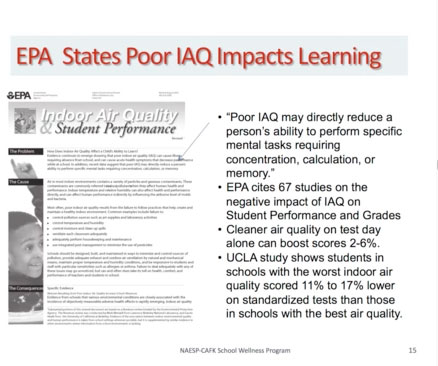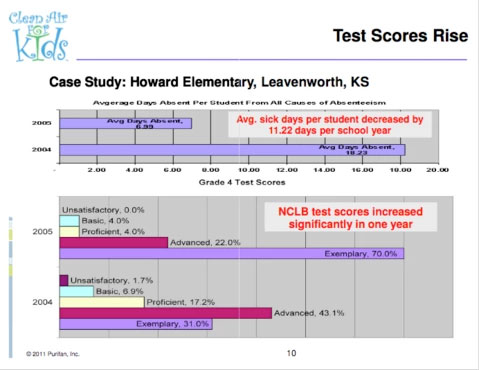How Schools Benefit from Clean Air in Elementary Classrooms
According to the Environmental Protection Agency (EPA), more than half the schools in the United States have poor indoor air quality. Older buildings can have hidden mold issues, and even the air in newer schools can have more allergens, pet dander and other particulates than the air outside. This can have a negative impact on students’ performance on daily work and standardized tests, and affect the health of everyone in the building.
Teachers, administrators and school boards who want to boost student test scores should consider improving the indoor air quality of their elementary schools.
The Solution: Purifan Air Filters
Purifan is a powerful, ceiling-mounted air filter that quietly cleans the air 40 times every hour. Schools who have installed them have seen the air particles in classrooms reduced by as much as 100%! Learn more about how Purifans work, or shop online for classroom bundles.
Improved Student Attendance
Schools that have improved their indoor air quality have seen the average number of student sick days reduced by as much as 11 per year. With fewer irritants and allergens in the air, fewer children were missing school for respiratory issues, allergies, and asthma.
Fewer Medications for Students
Reducing allergens and particulates in the air also reduced the need for students to use rescue inhalers and daily allergy medicines at school. These medications can be expensive for parents, a liability for schools, and make it difficult for children to concentrate in class. One nurse’s office actually recorded a 70% drop in inhaler use in the first year ofIncreased Test Scores with Purifanster installing air purifiers in classrooms!
Increased Test Scores
Fewer sick days and less mind-numbing medicines make it easier for students to focus and learn. The result is higher test scores on standardized tests.
Fewer Sick Days for Teachers and Staff
A school building with fewer indoor air quality problems should see a reduction in sick days for both students and teachers. Schools have reported they reduced teacher sick days by 50% and lowered their healthcare costs after installing classroom air purifiers. One teacher reported stopping medical treatments, resulting in a savings of $600 per month.
Other Benefits
In addition to providing healthier air quality for students and teachers, the movement of the air can eliminate hot and cold spots and actually save on the energy required to heat or air condition the rooms. Proper air filtration also cuts down on dust, which protects computers and electronics and reduces the need for dusting in classrooms.
Additional Benefits of Purifans
Lower Risk of Lawsuits
There have been cases where the impact of poor classroom air quality has led to lawsuits for some schools. Any building with a history of water damage from storms, floods or leaking windows or ceilings, a pipe breaking or toilet over-flowing, can have hidden mold issues and respiratory health issues for the occupants. The Centers for Disease Control (CDC) cites studies where respiratory health problems are 300% higher in buildings with a history of water damage. Getting rid of mold spores and particulates in the air can dramatically reduce the chances of negative effects on health due to poor indoor air quality.


